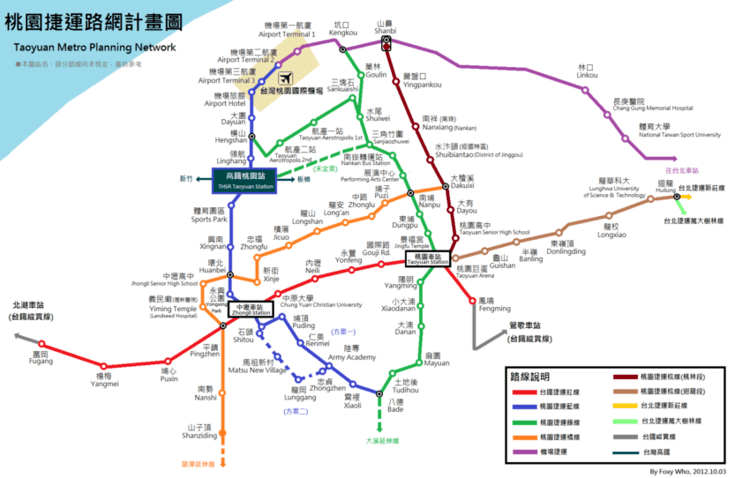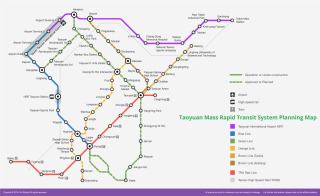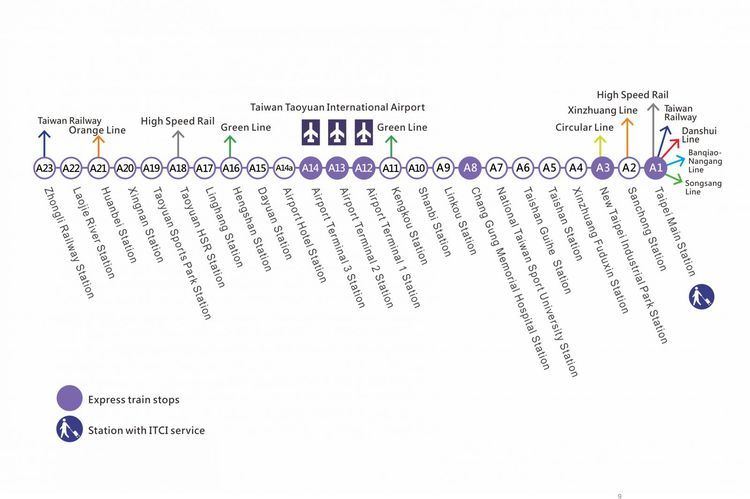Stations 21 | ||
Termini Taipei Main StationHuanbei Opened 2 February 2017 (trial)2 March 2017 (official) Similar THSR Taoyuan Station, Taipei Main Station, Taipei Railway Station, Chang Gung Memorial, Shanbi Station | ||
Taiwan taoyuan airport mrt line ready for take off
The Taiwan Taoyuan International Airport Access MRT, commonly known as the Airport MRT or Purple Line of Taoyuan Metro, is a rapid transit line which connects downtown Taipei and Taoyuan International Airport, before linking up with the Taoyuan MRT to THSR Taoyuan Station and onwards to Zhongli.
Contents
- Taiwan taoyuan airport mrt line ready for take off
- Taoyuan airport mrt
- Overview
- Operations
- Rolling stock
- History
- Timeline
- Construction
- Civil engineering
- Track
- Taipei Station
- Taoyuan Airport section
- Tamsui River section
- Chingshan Road section
- Stations
- Fares
- References

Taoyuan airport mrt
Overview
The route starts from Terminal 2 of Taoyuan International Airport and extends eastward, passing through Luzhu, Linkou, Guishan, Xinzhuang, and Sanchong, and before terminating in downtown Taipei. From the airport, it also extends south passing by THSR Taoyuan Station before terminating in Zhongli. The route is 51.03 km (31.71 mi) long with 7 underground stations, 15 elevated stations, and two maintenance depots (Qingpu and Luzhu). Elevated track makes up 40.11 km (24.92 mi) of the total route length. The total budget for the project is NT$93.6 billion. The line is expected to serve over 143,000 passengers per day. The line has a maximum operational speed of 100 km/h (62 mph).
Operations

Two types of services is offered: Commuter Trains and Express Trains. While both trains travel the same route, Express Trains stop at fewer stations and are specially provided for airport passengers. Commuter Trains, which stop at every station, operate from Taipei to Zhongli in 70 minutes, while Express Trains run from Taipei directly to Taiwan Taoyuan International Airport in 38 minutes. During the initial stage of operation, services run with a 10-minute headway for Express and Commuter Trains (or 5 minutes per train), with a target interval of 3.75 minutes between trains.

In-town check in and baggage check services are available at three stations: Taipei Main Station, New Taipei Industrial Park Station (future), and THSR Taoyuan Station, thus extending airline check-ins to downtown Taipei. Although check-in and baggage services have already been added at THSR Taoyuan Station, it is further streamlined with the completion of the MRT. Checked baggage is delivered to Terminal Two, where they are scanned and directed to the appropriate airline. Baggage handling equipment is installed, including check-in counters, conveyor belts, container handling equipment, container elevators, and control systems. Baggage is transported from the check-in counter into containers, which are loaded onto Express Trains. Flight information display system are installed at Express Train stops (A1, A3, and A8) as well as at THSR Taoyuan Station (A18). They are installed at check-in counters and in each Express Train car.
Rolling stock
The train sets are built by Kawasaki Heavy Industries.
Each car is powered by traditional, AC three-phase induction motors with 750 V DC power supplied via third rail. Four-car configurations are used for Commuter Trains, while Express Trains have five-car configurations due to an extra baggage car. The car body is constructed from stainless steel. In Commuter Trains, each train car has 50 longitudinal seats with two wheelchair areas and two luggage racks. Express Train cars are equipped with 54 seats with one wheelchair area and three luggage racks. Each train car has three doors per side, while the baggage car has five doors per side. An onboard baggage handling system, including control equipment, is installed. The first train set (of 28 ordered) were shipped at the end of July 2011 and started arriving by the middle of August 2011. Initial track testing for the first set began in October 2011. Of the 28 train sets, 11 are Express Trains while 17 are Commuter Trains. All Express Trains and one Commuter Train were constructed in Japan; the rest are made in Taiwan.
History
As one of the New Ten Major Construction Projects, a rail system to connect Taoyuan International Airport with existing transportation hubs was announced. This metro route was originally planned to be constructed as a BOT project. In 1998, the project was auctioned to Evertransit International Development Corp. (長生國際開發), a subsidiary of Ever Fortune Industrial Co. (長億實業). However, the company failed to begin the construction, and in 2003, the government cancelled the contract.
After the BOT project failed to go through, the Ministry of Transportation and Communications (MOTC) decided to build the line directly from the government budget. The terminus in Taipei was shifted from Ximen to Taipei Main Station to facilitate transfers to other forms of public transportation (including TRA and THSR). There were disagreements between the MOTC and the Taipei City Government regarding the exact location of the terminal station. The MOTC preferred an elevated station just north of the Taipei Main Station, while the City Government wanted it built underground just west of Chengde Road. The MOTC's plan was less expensive and would require less time to construct, but it would have obstructed the scenery of the surrounding area. The two sides finally compromised, agreeing to build the station underground with the City Government covering the additional cost. The revised project was approved in September 2004 and construction began on September 25, 2006.
A special industrial zone is planned around the THSR Taoyuan Station area. Land acquisition for the Sanchong City section totaled 2.07 ha (20,700 m2) and cost NT$1.4 billion, including land and buildings.
Construction began in 2006 and was plagued by multiple delays. The majority of the line was originally scheduled for completion in 2013. The system began commercial service on March 2, 2017. The Bureau of High Speed Rail of the Ministry of Transportation and Communications oversaw construction.
February 2, 2017 to March 1, 2017 was a trial operation phase of the Airport MRT. Trial operation time was 8:00 am to 4:00 pm (from 2 February 2017 to 1 March 2017 operation time was extended to 7:00 am to 9:00 pm). Passengers could get a free voucher at any Airport MRT station before 1:30 pm. There was a limit of 20,000 vouchers per day and the voucher were only valid on the day issued.
Timeline
Construction
The entire system cost NT$113.85 billion. The first train sets from Kawasaki Heavy Industries were delivered in July 2011. Platform screen doors are installed at all underground stations, while elevated stations are equipped with automatic platform gates. By July 2011, the last of the line's elevated support pillars were erected and by August 2011, construction of the elevated viaducts were completed.
In addition to tracks and stations, joint development projects have been constructed to boost development around stations. In April 2011, Kingdom Construction Corp. signed a contract to construct a 16-story residential and commercial building near Linkou Station.
Civil engineering
The design of core E&M systems (including rolling stock, power supply, signaling, communications, depot equipment, platform screen doors, etc.) and the design and construction of two depots (Qingpu and Luzhu) were awarded as part of a contract worth NT$25.5 billion. Hitachi, in cooperation with Marubeni Corporation and Kawasaki Heavy Industries, won the bid for the E&M systems and signed the contract on January 12, 2006. The groundbreaking ceremony for the power supply system was held on October 1, 2010 on behalf of five contractor companies including Hitachi. Motorola supplied the digital radio communications system for the line.
The power supply for the system is drawn from two Taiwan Power Company 161 kV supplies at three Bulk Supply Substations (BSS); one incoming line serves as the main power supply while the other serves a backup. One substation (A8) is located between Chang Gung Memorial Hospital and Linkou stations. The main RC structure was completed in March 2011, while civil engineering was finish at the end of October. The automatic fare collection system contract was awarded to Mercuries Data Systems (MDS) on October 22, 2010 for NT$355 million.
Track
Of the total 51.03 km (31.71 mi) route length, 10.92 km (6.79 mi) was constructed underground while 40.11 km (24.92 mi) is elevated. A large portion (78.6%) of the route length is constructed on 9.3 m (31 ft)-wide viaducts, which is used in both dense urban districts as well as rural areas with steep slopes. Two types of viaducts, single-tracked and double-tracked, are used. Single-tracked viaducts were constructed with a standard span of 30 m (98 ft) with mobile cranes. Double-tracked viaducts were constructed using the Advanced Shoring Method for either 35 m (115 ft) or 60 m (200 ft) spans. A 4 m (13 ft) noise barrier wall is used on all viaducts, and floating track beds are used for environmentally-sensitive zones. During construction, some residents in Xinzhuang expressed concern over the 7 to 9-story high elevated track and its stability during potential earthquakes. The Bureau of High Speed Rail responded that due to a base which penetrates 20–30 m (66–98 ft) into the ground, the tracks could withstand earthquake shake intensity over 5 without a problem. The system is based on steel wheel on steel rail technology.
RAIL.ONE Group provided the RHEDA 2000 ballastless track system for the line. 150,000 modified bi-block type B 355 ties were delivered for the line. The first set arrived between July and December 2010, while the last set began production in March 2011.
A section crossing over National Highway No. 1 employs a V-shaped support system (instead of the usual vertical supports) and began construction in July 2009.
Taipei Station
The Taipei terminus is situated under the future Gate of Taipei twin towers and is designed by architect Fumihiko Maki. The station itself extends five stories underground. The diaphragm wall is 53 meters deep and excavation depth was around 27 meters. Four underground levels were constructed: three for the terminus of the station and one for a parking lot. China Engineering Consultants, Inc. (CECI) won the contract for construction of the Taipei City section through public appraisal on July 8, 2005. Redevelopment of the 47 hectares (470,000 m2) area will comprise of retail, office, and hotel components.
Taoyuan Airport section
The entire airport section consists of four underground stations (A12 to A14a) and is 6.85 km (4.26 mi) long. Both cut-and-cover and shield tunneling were used for tunnel construction. Since shield tunnels were constructed underneath existing taxiways and the control tower area, an automatic monitoring system was used to assess the impact to the soil and structures so that a response can be made in time. In the same section, secondary grouting and a micro-pile cut-off wall was used to reinforce the tunnels. In addition, a floating track bed was used for the tracks crossing these areas to reduce vibrations. Continental Engineering Corporation constructed the underground stations and the tunnels in this section.
Five shield tunneling sections totaling 3,600 m (11,800 ft) and 1,630 m (5,350 ft) of cut-and-cover sections were excavated. Arrival areas near the MRT departure areas were constructed.
Tamsui River section
The section passing below Tamsui River (about 1 km in length) employed the shield-tunneling method. The double-O-tube (DOT) shield tunnel machine was used for the first time in Taiwan. The 1.58 km (0.98 mi)-long tunnels took 12 months to dig, and were completed in December 2010.
Chingshan Road section
This section was built along a steep roadside slope. Traditional construction methods would greatly increase the difficulty, cost, and excavation area necessary to build an elevated line through the area. In order to reduce environmental impact and cut construction time, a bamboo-cut treatment was used in construction to keep the slope intact. Top ring girders 11.4 m (37 ft) in diameter were used to gradually excavate the area, after which a 10 m (33 ft) diameter foundation can be placed. A total of 15 bamboo-cut foundations were constructed, ranging from a height of 5.88 to 16.35 meters. By June 2010, the contractor (Fu Tsu Corporation) had completed 13 of the 15 bases, with the additional two under construction.
Stations
Several stations were selected for public art installations.
Fares
One-way ticket prices range from NT$30 to NT$160.
For local commuters, 30, 60, and 90-day periodic tickets are available, offering up to 40% discounts.
